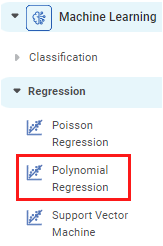Polynomial Regression | |||
Description | Polynomial Regression is a supervised learning method in which the relationship between the independent and dependent variables is modeled as an nth degree polynomial. | ||
Why to use | Predictive Modeling | ||
When to use | When the data points are not captured by the Linear Regression Model and the Linear Regression fails in describing the best result clearly. | When not to use | On Textual data. |
Prerequisites |
| ||
Input | Any continuous data | Output | The predicted value of the dependent variables. |
Statistical Methods used |
| Limitations | It cannot be used on textual data. |
Polynomial Regression is located under Machine Learning () under Regression, in the left task pane. Use the drag-and-drop method to use the algorithm in the canvas. Click the algorithm to view and select different properties for analysis.
Refer to Properties of Polynomial Regression.
Polynomial Regression is a specific case of Linear Regression. In Polynomial Regression, a polynomial equation is fitted between the dependent and independent variables. It establishes a curvilinear relationship between the dependent variable and independent variables. In a curvilinear relationship, the value of the dependent variable changes in a non-uniform manner with respect to the independent variables.
Properties of Polynomial Regression
The available properties of Polynomial Regression are as shown in the figure given below.
The table given below describes the different fields present on the Properties pane of Polynomial Regression.
Field | Description | Remark | |
Task Name | It is the name of the task selected on the workbook canvas. | You can click the text field to edit or modify the name of the task as required. | |
Dependent Variable | It allows you to select the dependent variable. |
| |
Independent Variables | It allows you to select independent variables. |
| |
Advanced | Degree | It allows you to select the degree of the polynomial equation to be used. | The default value is 2. |
Interaction Only | It allows you to select whether interaction features are to be produced. |
| |
Include Bias | It allows you to select whether bias is to be included. |
| |
Dimensionality Reduction | It allows you to select the method for dimensionality reduction. |
| |
Add result as a variable | It allows you to select whether the result of the algorithm is to be added as a variable. | For more details, refer to Adding Result as a Variable. | |
Node Configuration | It allows you to select the instance of the AWS server to provide control on the execution of a task in a workbook or workflow. | For more details, refer to Worker Node Configuration. | |
Hyper Parameter Optimization | It allows you to select parameters for optimization. | For more details, refer to Hyperparameter Optimization. | |
Example of Polynomial Regression
Consider a dataset of Credit Card balances of people of different gender, age, education, and so on. A snippet of input data is shown in the figure given below.
We select Limit, Balance, Income, and Cards as the independent variables and Rating as the dependent variable. The result of the Polynomial Regression is displayed in the figure below.
As seen in the above figure, on the Result page, under the Regression Statistics, the Performance Metrices and Coefficient Summary are displayed.
The table below describes the various performance metrics on the result page.
Performance Metric | Description | Remark |
RMSE (Root Mean Squared Error) | It is the square root of the averaged squared difference between the actual values and the predicted values. | It is the most commonly used metric to evaluate the accuracy of the model. |
R Square | It is the statistical measure that determines the proportion of variance in the dependent variable that is explained by the independent variables. | Value is always between 0 and 1. |
Adjusted R Square | It is an improvement of R Square. It adjusts for the increasing predictors and only shows improvement if there is a real improvement. | Adjusted R Square is always lower than R Square. |
AIC (Akaike Information Criterion) | AIC is an estimator of errors in predicted values and signifies the quality of the model for a given dataset. | A model with the least AIC is preferred. |
BIC (Bayesian Information Criterion) | BIC is a criterion for model selection amongst a finite set of models. | A model with the least BIC is preferred. |
On the Result page, when you scroll down Number of Input and Output features are also displayed, as shown in the figure below.
The result page also shows tables that show Variance Inflation Factor and Feature Importance for each of the selected independent (predictor) variables.
Feature importance refers to methods that assign a score to input features based on how useful they are for predicting the dependent variable.
- It indicates the relevance of each of the independent variables to the dependent variable.
Table of Contents




